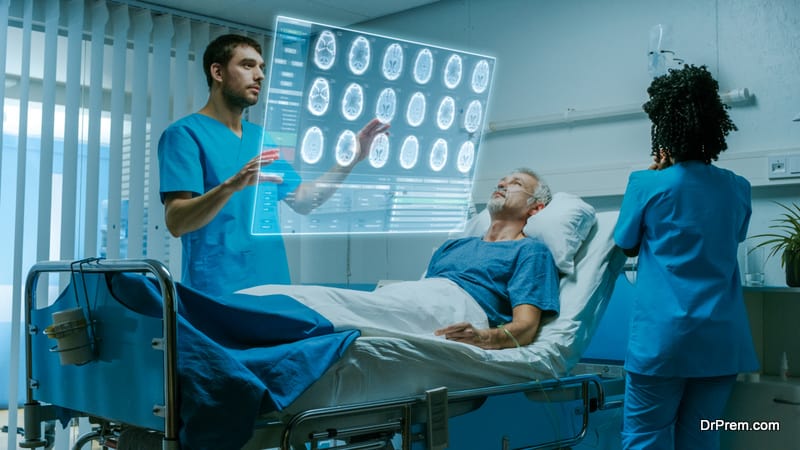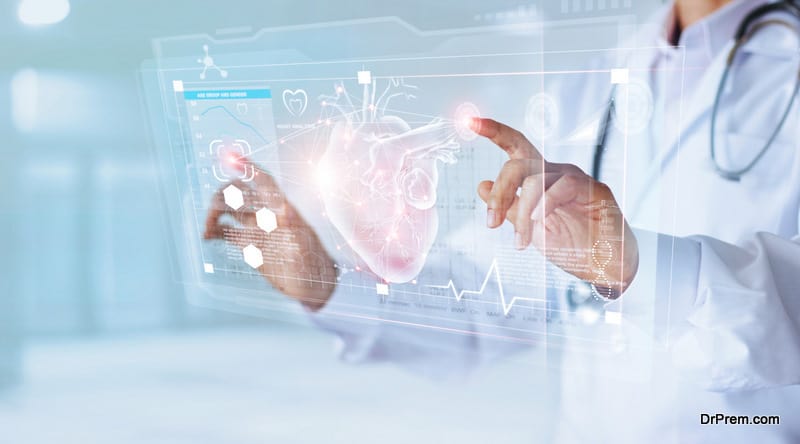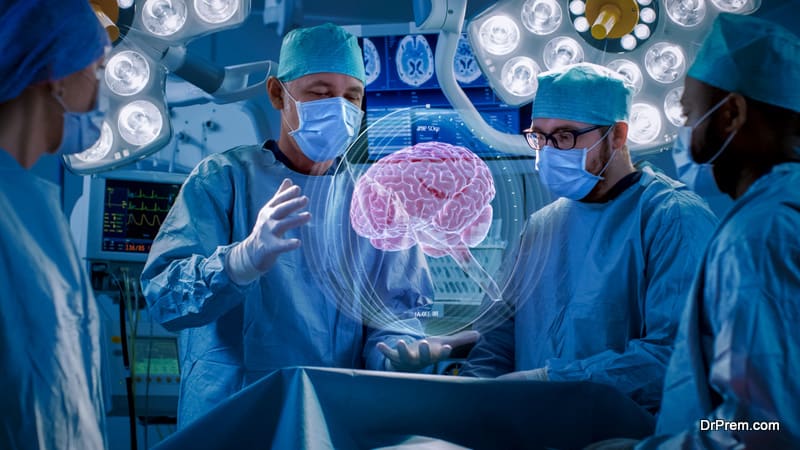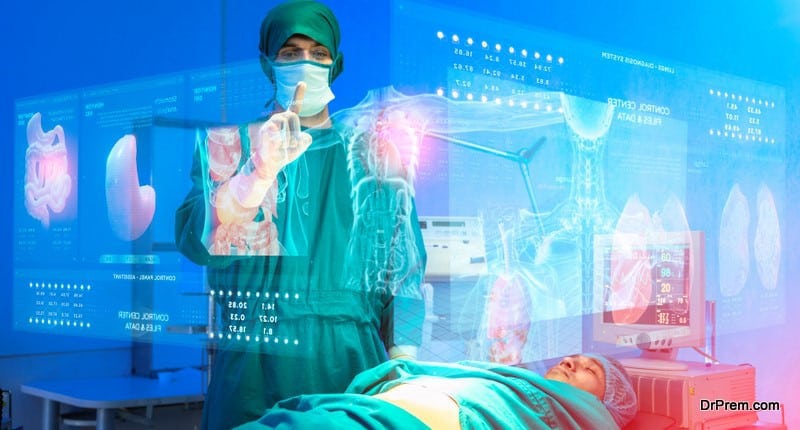The realities VR and AR have been creating waves in global healthcare. But the future belongs to Mixed Reality (MR) for better coordination and analysis delivering treatment procedures in a more convenient manner. Growing interest among researchers to explore virtual and augmented reality applications has opened up interesting aspects in healthcare. Today, healthcare procedures demand a higher level of accuracy and analytical ability that could be only feasible with MR.
Is mixed reality the next big thing in global healthcare?
-
Mix of realities
-
Applications in healthcare
-
Surgical Applications
-
Simplification and precision of medical procedures
-
Interactive medical training
-
Ameliorating patient experience
-
Better Imaging
-
Real time diagnostic analysis
-
A decrease in time and human mistake in reconstruction surgery
Mixed Reality aka Hybrid Reality or Extended Reality is a programmed mix of Virtual and Augmented reality (AR & VR). By 2026, the global AR and VR market in healthcare is expected to touch $7.5 billion. Therefore, it is obvious that mixed reality will find increased application. This futuristic and hi-tech scientific know how would positively influence healthcare services among other areas like education, entertainment and the corporate world.
Mix of realities
VR applications offer an immersive experience painting totally a new reality around the user or patient. He/she is cut off from the real world. In Augmented Reality applications, the user does not get isolated from the real world but digital information from the real word gets augmented. With VR, people get a better insight of the real world and its associated systems through easy accessibility.
To leverage the immersive visual experience and enhance the interactive feature of augmented reality, scientists have built the concept of mixed reality. It enables real-time virtual interaction along with controlling the system and equipments in the real world.
Applications in healthcare
If you see the entire package of an efficient healthcare service a constitution of several products, mixed reality would modify the way these products are delivered. Here are several applications for us to explore how well mixed reality would handle clinical cases:
Surgical Applications
Surgical applications of mixed reality would bring in novel procedures that are way different from what is being practiced currently. Operations on patients would yield more success with surgeons wearing virtual reality headsets where augmented reality technology has been inbuilt. Image-guided surgery is a new term in the field of medicine where mixed reality technology will have a significant participation. Surgeons would deliver their duties with greater accuracy.
The gadgets will enable doctors to access real time information on the patients’ health parameters. Consequently, monitoring these parameters for likely fluctuations and control during a surgery would be easy and precise. A non-intrusive scanning system would give the surgeons instant real time images of patient’s organs. As fallout they can stay tuned to changes taking place in patient’s system during the surgery.
Dr Dimitri Amiras of the Imperial College Healthcare National Health Service Trust in the UK has given a very promising picture of MR in surgical applications. Clinicians with the help of mixed reality technology are able to view the internal anatomy of the patient on the body itself.
The imaging information of a patient who was supposed to undergo a leg surgery was focused on. The information was extrapolated to a 3 D model that was aligned with AR software. Later, the patient’s vascular anatomy was shown where the surgeons performed the operation without tearing any arteries or veins.
Simplification and precision of medical procedures
Medical procedures demand absolute precision and concentration. On top of that the analytical skill of the doctor for diagnosis and effective treatment is a prime requisite. Mixed reality has a crucial role over here, eliminating complications in procedures. Not only the treatment is discharged with high level efficiency, it becomes safer for the patients as well.
Interactive medical training:
Mixed Reality in global healthcare has not only improved and simplified treatment procedures but also has helped in training the minds of the doctors too. Medical students benefit a lot while undergoing professional training when mixed reality technology comes to the fore. A carefully programmed combination of mixed reality, artificial intelligence and computer simulated models is an innovative training model.
They can help medical students working with corpses to enhance their knowledge of human anatomy. The entire study turns fascinating for the students who have started gathering anatomical information by simply replicating a live patient. The visual clarity of a real time surgical procedure is achieved through this kind of mixed reality aided exercise.
Ameliorating patient experience
Doctors – patient relationship does its bit in fast recovery of the patient. This is mostly mental and to some extent physical as well. The entire premise of this relationship is based on the depth of faith in the mind of the patient for the doctor. Trust again rests on an effective communication between the doctor and the patient. Transparency plays a major role over here and mixed reality has a contributory role in this area too. Doctors can give patients access to virtual scanned images.
The patients can see their own MRI scans and get an insightful detail of the surgical procedures. The basic idea is the patient is not left in the dark. He knows his physical condition better. Mixed reality also helps cut down the patient response time. It improves surgical precision and this improves patient experience too. The entire stay in the clinic becomes smooth for the patient. He feels more relaxed, self assured with trusted doctors and dedicated advanced medical gadgets around.
In case the patient’s health parameters turn alarming or the surgical procedures turn complicated, diagnostic images aided by mixed reality can become a replica of the patient. Drawing information from images the physicians can make plans and take actions to mitigate patient response time. Mixed reality enables doctors to receive vital information on the patients which helps in real life simulation. All his actions leading to a successful treatment depends on how good simulations are.
Better Imaging
Mixed reality has improved the technology of imaging. Imaging experts study medical scans on computer screens and do a lot of fine tuning to scrutinize the image and magnify critical zones for in-depth study. Practically, Mixed Reality technology can identify the exact spot where the imaging expert is focused on and reacting to movements.
This provides a better way to study an image because study wise there is hardly any difference between the real object and the image. Analysis of patient anatomy and disease becomes more accurate and meaningful. Modern imaging technology generates 3D images, when mixed reality comes in, images can be explored with deeper insights.
Real time diagnostic analysis
Mixed reality has brought in a lot of modifications in diagnosis of patients. The techniques are sophisticated and meticulously designed to rule out any erroneous report leading to wrong medical actions. Diagnosis is the first vital step in an entire treatment package. The quality of cues you get from a correct diagnosis eventually makes all the difference between a treatment success and failure.
A lot of application of mixed reality can be traced to diagnostic analysis of a patient for identification of existing disease. Use of mixed reality techniques not only covers digital images of patient’s system to aid further diagnosis, MR glasses enables patients to have a glimpse of their own real time scans. Since this are 3 D images, a deeper understanding of the images here is possible when compared against 2 D images.
A decrease in time and human mistake in reconstruction surgery
Mixed reality has been applied in reconstruction surgery where use of HoloLens has been giving positive results. The study was carried out in the Imperial College at St Mary’s Hospital, London. The entire team involved in MR technology aided reconstruction surgery was supervised by Dr. Philip Pratt. With the help of mixed reality the surgeons are able to pinpoint and restore link between different blood vessels.
With HoloLens, surgeons can apply holographic techniques to visualize the bones and trace the blood vessels. This is immensely beneficial for surgical cases where the patients get well without any complaints.
An article was published in the Times revealed that how a mixed reality- aided reconstruction surgery was successfully carried out on a male aged 41 years and a female aged 85 years. It was a story of the impact of modern technology on surgery carried out with precision and followed by fast recovery.
Final thoughts
In a nutshell, Mixed Reality creates a virtual hospital for you. The updated Hololens is loaded with more cutting-edge features promising to create a bigger impact on global healthcare. Instant patient detection and seamless information transmission to physicians and doctors would cut off the cumbersome paperwork and save time. Quicker intervention will be life saving and facilitate faster recovery.
Good news for geriatric patients! They will receive nearly hospital-level support and care from home without stepping out. Days are not far when other patients needing frequent clinic visits will also benefit with the HoloLens app. Specialists will be able to provide personalized care to patients enabling them substantial savings in time and money not to speak of other hassles. In the other way, advancements in realities will help physicians and other medical professionals hone their skills and virtually attend a huge volume of patients without even making any physical contact.









